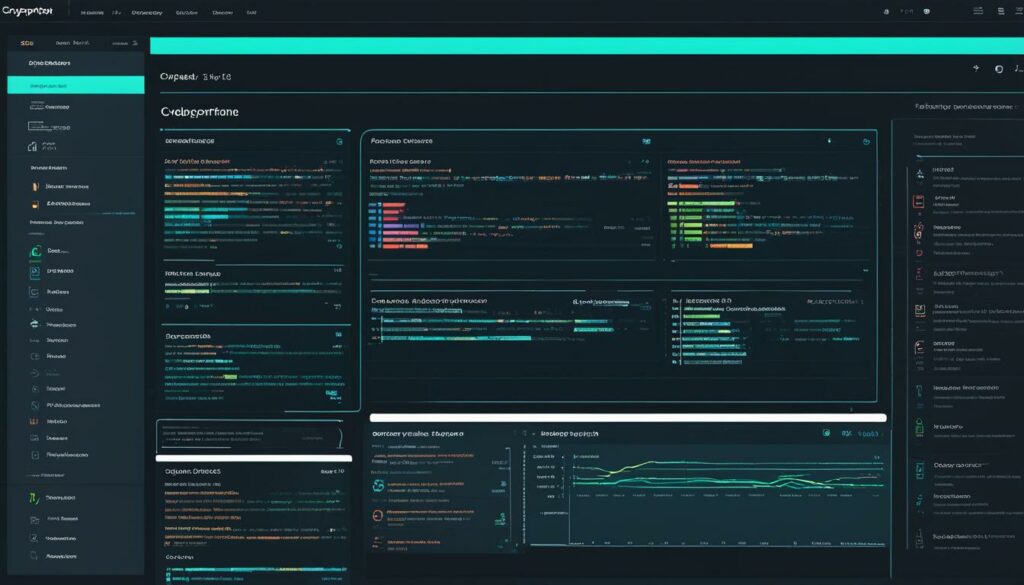Welcome to our guide on PostgreSQL, the open-source database management system that is widely acclaimed for its advanced features and capabilities. Whether you’re a developer, data analyst, or business owner, understanding PostgreSQL can greatly enhance your data storage and management practices.
PostgreSQL is a powerful and versatile open-source database that provides a reliable solution for storing and managing data. As a database management system, it enables efficient data storage, retrieval, and manipulation. PostgreSQL is renowned for its support of SQL, the standard query language used in relational databases.
With PostgreSQL, you can create and manage complex relational databases, ensuring that your data is organized and accessible. It acts as a robust database server, hosting your data and facilitating interactions between applications and your database.
One of the key advantages of PostgreSQL is its status as an open-source database. This means that the source code is freely available, allowing developers and users to contribute to its development and adapt it to their specific needs. The open-source nature also contributes to the continuous improvement and stability of PostgreSQL.
Whether you are managing a small-scale project or a large-scale enterprise system, PostgreSQL offers a wide range of features that can meet your data management requirements. Its extensibility, stability, and support for SQL and relational databases have made it a popular choice for many businesses and organizations, including Apple, Fujitsu, Red Hat, Cisco, and Juniper Networks.
Key Takeaways:
- PostgreSQL is an open-source database management system designed for efficient data storage and management.
- It supports SQL and offers a wide range of features suitable for small-scale projects and large-scale enterprise systems.
- PostgreSQL is renowned for its stability, extensibility, and support for relational databases.
- Companies like Apple, Fujitsu, Red Hat, Cisco, and Juniper Networks have adopted PostgreSQL for their data management needs.
- Sign up for WordPress Hosting from BoostedHost for optimal performance.
Brief History of PostgreSQL
PostgreSQL, originally known as the POSTGRES project, was started by Michael Stonebraker in 1982. It evolved from the Ingres Project and aimed to address the limitations of contemporary database systems. Stonebraker, an influential figure in the field of database systems, received the Turing Award in 2014 for his contributions to the project.
“We started the POSTGRES project to build the next generation of database systems. We wanted to create a system that would offer advanced features, support for complex data types, and extensibility.”
The initial version of PostgreSQL was designed for UNIX-like platforms, but over the years, it has been adapted to run on other platforms including Mac OS X, Solaris, and Windows. One notable aspect of PostgreSQL is its availability under an open source license, which allows anyone to use, modify, and distribute the source code.
The open source nature of PostgreSQL has led to its widespread adoption and continuous development by a vibrant community of developers and contributors. PostgreSQL has become one of the most popular and trusted database systems, offering reliability, stability, and the flexibility to meet diverse business needs.
Michael Stonebraker and the Ingres Project
Michael Stonebraker, a renowned computer scientist, led the development of the Ingres project in the 1970s. Ingres was an early computer database management system that introduced new concepts and techniques, such as the use of the SQL query language.
Building upon the foundations laid by the Ingres project, Stonebraker and his team at the University of California, Berkeley, embarked on the ambitious POSTGRES project. Their goal was to create a more advanced and extensible database system that could overcome the limitations of existing solutions.
Key Milestones and Influences
The development of PostgreSQL has been marked by several key milestones:
- The inception of the POSTGRES project in 1982, driven by the vision of Michael Stonebraker and his desire to push the boundaries of database systems.
- The release of the initial version of PostgreSQL, which introduced innovative features like support for user-defined data types, extensibility, and complex queries.
- The adoption of an open source license, enabling the widespread use, collaboration, and improvement of PostgreSQL by developers around the world.
- The continuous evolution of PostgreSQL through regular updates, additions, and optimizations, ensuring its relevance and competitiveness in the ever-changing landscape of database systems.
Each of these milestones has contributed to the growing success and recognition of PostgreSQL as a leading open source database system used by organizations of all sizes and industries.
POSTGRES to PostgreSQL: A Name Change
“To reflect the evolving nature of the project and its expanded capabilities, the name of the project was changed from POSTGRES to PostgreSQL in 1996.”
This name change emphasized the maturity and broad capabilities of the database system, while maintaining continuity with its origins. PostgreSQL has since established itself as a reliable, scalable, and feature-rich database solution, powering mission-critical applications and serving as the backbone of numerous businesses worldwide.
Key Features of PostgreSQL
PostgreSQL, as an advanced database management system, offers numerous key features that make it a highly regarded choice among users. Let’s explore some of these features:
- User-Defined Types: PostgreSQL allows you to create custom data types, tailored to your specific needs and requirements.
- Table Inheritance: With table inheritance, you can inherit the structure and properties of a parent table, simplifying the management of complex data relationships.
- Locking Mechanism: PostgreSQL implements a sophisticated locking mechanism to ensure data consistency and prevent conflicts between concurrent transactions.
- Foreign Key Referential Integrity: PostgreSQL supports foreign key constraints, ensuring the integrity and accuracy of data references between tables.
- Views: Views provide a way to create virtual tables based on the result of a query, simplifying complex data access and enhancing security.
- Rules: PostgreSQL’s rule system allows you to define actions to be performed automatically when specified conditions are met, enabling automation and simplifying business logic implementation.
- Subquery: With subqueries, you can nest one query within another, providing powerful and efficient ways to retrieve and manipulate data.
- Nested Transactions: PostgreSQL supports nested transactions, allowing you to perform multiple levels of transactional operations within a single transaction block.
- Concurrency Control: The multi-version concurrency control (MVCC) mechanism in PostgreSQL ensures consistent and concurrent access to data by multiple transactions.
- Replication: PostgreSQL offers asynchronous replication, allowing you to create copies of your database for read scalability and fault tolerance.
- Tablespaces: Tablespaces in PostgreSQL allow you to organize your data storage across different file systems or disks, optimizing performance and manageability.
- Point-in-Time Recovery: PostgreSQL enables point-in-time recovery, allowing you to restore your database to a specific timestamp in case of data loss or system failure.

These key features make PostgreSQL a versatile and powerful database management system, providing robust capabilities for data storage, manipulation, and security.
Benefits of PostgreSQL
PostgreSQL is a highly versatile and robust open-source database management system that offers numerous benefits to users. Whether you are a developer, data analyst, or IT professional, PostgreSQL’s advanced features and extensive capabilities make it an ideal choice for your database needs.
Customizability and Extensibility
One of the key advantages of PostgreSQL is its advanced features and flexibility. With PostgreSQL, you have the power to customize and extend the database according to your specific requirements. From user-defined types to table inheritance, PostgreSQL allows you to tailor the database to suit your unique needs.
“With PostgreSQL, you have the power to customize and extend the database according to your specific requirements.”
Stability and Low Maintenance
PostgreSQL is renowned for its stability and reliability. It is designed to handle large datasets and complex workloads without compromising performance. With PostgreSQL, you can rest assured that your data is safe and that the database requires minimal maintenance effort.
Robust Community Support
One of the key strengths of PostgreSQL is its robust community support. With a large and active community of users and contributors, PostgreSQL benefits from ongoing development and improvement efforts. This means that you can rely on a dedicated community to help you troubleshoot issues, share knowledge, and keep the software up-to-date.
Overall, PostgreSQL offers advanced features, extensibility, stability, low maintenance, and robust community support. It is a highly reliable and customizable database management system that caters to a wide range of user needs. Whether you are managing small datasets or handling large-scale data workloads, PostgreSQL is a powerful choice for efficient data storage and management.
Use Cases and Users of PostgreSQL
PostgreSQL is a versatile and powerful open-source relational database management system that is widely used across various industries and by numerous companies. Its robust features and capabilities make it suitable for a wide range of use cases.
One of the main industries that heavily relies on PostgreSQL is the computer software industry. Many software companies leverage PostgreSQL for its scalability, performance, and reliability in managing vast amounts of data. Additionally, information technology and services firms also utilize PostgreSQL for data storage and management, taking advantage of its advanced features and extensibility.
PostgreSQL finds applications beyond the software industry as well. It is extensively used in hospitals and healthcare organizations to store and manage patient records, medical research data, and administrative information. Higher education institutions also rely on PostgreSQL for storing student information, academic data, and research records.
Financial services companies also choose PostgreSQL for its security features, performance, and scalability. PostgreSQL provides a robust platform to handle complex financial data, transactions, and reporting requirements. Similarly, telecommunications companies leverage PostgreSQL to store and manage vast amounts of customer data, call records, and network performance information.
PostgreSQL also plays a crucial role in the marketing and advertising industry, enabling data-driven marketing campaigns and analysis. It helps marketing professionals store and process large datasets, track user behavior, and gain valuable insights for targeted advertising and customer segmentation.
Even government agencies, such as the FBI, recognize the value of PostgreSQL for their data storage and management needs. PostgreSQL’s reliability, scalability, and security features make it an ideal choice for handling sensitive government data.
Many prominent companies rely on PostgreSQL as a key component of their technology stack. Apple, Fujitsu, Red Hat, Cisco, and Juniper Networks are just a few examples of companies that have built successful products and solutions using PostgreSQL.
To summarize, PostgreSQL’s widespread adoption can be attributed to its versatility and suitability for diverse use cases. It serves as a reliable and efficient database management system across various industries, from software development to healthcare and government agencies.
| Industry | Use Cases |
|---|---|
| Computer Software | Data storage, management, and analysis |
| Information Technology and Services | Data storage, management, and scalability |
| Hospitals and Healthcare | Patient records, medical research, administration |
| Higher Education | Student information, academic data, research |
| Financial Services | Financial data, transactions, reporting |
| Telecommunications | Customer data, call records, network performance |
| Marketing and Advertising | Data-driven marketing, user behavior analysis |
| Government Agencies | Sensitive data storage and management |
You can trust PostgreSQL to deliver secure, scalable, and efficient solutions for your specific use case needs. Whether you’re a small startup or a large enterprise, PostgreSQL offers the flexibility and reliability necessary to handle your data storage and management requirements effectively.

Getting Started with PostgreSQL
Getting started with PostgreSQL is a straightforward process. You have two options to choose from: manual installation on Windows or using a managed PostgreSQL service like Aiven for PostgreSQL.
Manual Installation on Windows
If you prefer to install PostgreSQL manually on Windows, you can follow the step-by-step installation instructions provided by the official PostgreSQL website. These instructions will guide you through the process of downloading and installing PostgreSQL on your Windows machine.
After completing the installation, you will have a fully functional PostgreSQL database management system on your Windows system. You can then start exploring the features and capabilities of PostgreSQL and begin using it for your data storage and management needs.
Using Aiven for PostgreSQL
If you want a hassle-free experience and prefer a managed PostgreSQL service, you can choose Aiven for PostgreSQL. Aiven simplifies the setup and maintenance process, allowing you to focus on utilizing PostgreSQL without worrying about the technical details.
Aiven provides a user-friendly interface that makes it easy to create and manage PostgreSQL instances. It also offers additional features and support specifically designed for PostgreSQL, ensuring that your experience with the database is smooth and efficient.

Whether you choose manual installation on Windows or a managed service like Aiven for PostgreSQL, you can start leveraging the power of PostgreSQL to efficiently manage your data and drive your business forward.
Advanced Features of PostgreSQL
PostgreSQL, being an advanced and versatile open-source relational database management system, offers a range of advanced features that enhance its functionality. These features provide users with the tools they need to efficiently store, manage, and manipulate data. Let’s explore some of these advanced features:
1. Materialized Views
Materialized views in PostgreSQL allow you to store the results of a query as a physical table. Unlike regular views, materialized views are not recalculated every time they are accessed. Instead, they can be refreshed on schedule or manually. This feature improves query performance by precomputing the results and reducing the overhead of executing complex queries repeatedly.
2. Triggers
Triggers are powerful database objects in PostgreSQL that allow you to execute custom code automatically in response to changes made to a table or view. With triggers, you can enforce business rules, perform data validation, update related tables, and maintain data integrity. They provide a flexible way to add custom logic to your database operations.
3. Stored Procedures
Stored procedures are precompiled and stored in the database, allowing you to create reusable code that can be executed anytime. They contain a series of database operations that can be invoked using a single function call. Stored procedures provide modularity, encapsulation, and improved performance for complex database tasks, making them a valuable asset for developers and database administrators.
4. Logical Replication
Logical replication in PostgreSQL allows for the replication of data changes between databases using a publisher-subscriber model. It enables you to replicate specific tables or specific events, providing flexibility and granularity. Logical replication is useful for various scenarios, such as creating high availability setups, distributing data across multiple databases, or migrating data between different environments.
5. Change Data Capture
Change data capture (CDC) is a feature that captures and records all changes made to a database, allowing you to track and analyze historical data modifications. PostgreSQL CDC enables the capturing of row-level changes, the ability to identify when and where a change occurred, and the option to rewind and replay changes when needed, making it invaluable for auditing, compliance, and disaster recovery purposes.
These advanced features of PostgreSQL significantly enhance its capabilities and provide developers and administrators with powerful tools for efficient data management and manipulation.

Are you interested in harnessing the power of PostgreSQL for your projects? BoostedHost offers optimized WordPress Hosting that ensures optimal performance and reliability. Sign up now through this link: www.boostedhost.com/wordpress-hosting.
Data Security in PostgreSQL
When it comes to data security, PostgreSQL takes the protection of your valuable information seriously. With a wide range of advanced security features, PostgreSQL ensures that your data remains safe and secure.
Authentication is a crucial aspect of data security, and PostgreSQL supports various authentication methods to ensure that only authorized users can access your database. These methods include GSSAPI, SSPI, LDAP, and SCRAM-SHA-256, providing flexibility and compatibility with different security protocols.
Access control mechanisms in PostgreSQL allow you to define fine-grained permissions and restrictions, ensuring that only the right users have appropriate levels of access to your data. This helps prevent unauthorized access and ensures the integrity of your database.
Encryption is another vital component of data security, and PostgreSQL offers encryption options to protect sensitive information. You can encrypt data at rest and in transit, safeguarding it from unauthorized access. This ensures that even if a breach occurs, the encrypted data remains virtually unreadable.
PostgreSQL’s data dictionaries provide valuable insights into your database and its structures. They contain metadata about your data, helping you better understand the organization and relationships within your database. This information is useful for security audits and system analysis.
One of PostgreSQL’s strengths is its extensibility, which allows you to customize and enhance security features to meet your specific requirements. You can incorporate additional security modules and add-ons, making PostgreSQL highly adaptable to your evolving data security needs.
Overall, PostgreSQL offers robust data security features, including authentication, access control, encryption, data dictionaries, and extensibility. By leveraging these capabilities, you can safeguard your data and ensure the confidentiality, integrity, and availability of your database.
Scalability and Performance of PostgreSQL
When it comes to handling large amounts of data and concurrent users, PostgreSQL shines in terms of scalability and performance. This open-source database management system can seamlessly accommodate growing data workloads while maintaining optimal performance. Let’s explore some key features that contribute to PostgreSQL’s scalability and performance.
Concurrent Transactions
PostgreSQL employs concurrent transaction processing, allowing multiple transactions to be executed simultaneously. This ensures that multiple users can access and modify the database concurrently without causing conflicts or data inconsistencies. By effectively managing concurrent transactions, PostgreSQL facilitates efficient data processing and improves overall system performance.
Write-Ahead Logging
Write-ahead logging is a key mechanism in PostgreSQL that ensures data integrity and durability. It involves recording all changes to the database in a log file before applying them to the actual data files. This logging approach provides the ability to recover the database in the event of a system failure or crash. By implementing write-ahead logging, PostgreSQL minimizes the risk of data loss and enhances the overall reliability of the system.
Parallelization
PostgreSQL leverages parallelization techniques to enhance query processing speed and improve performance. By breaking down complex queries into smaller tasks and distributing them to multiple processors or cores, PostgreSQL can execute queries in parallel, significantly reducing execution time and increasing overall efficiency. This feature is especially advantageous when dealing with resource-intensive operations or analytical tasks involving large data sets.
Table Partitioning
Table partitioning is a powerful feature offered by PostgreSQL that enables the efficient organization and retrieval of data. It allows large tables to be divided into smaller, more manageable partitions based on specified criteria such as date ranges or specific column values. By partitioning tables, PostgreSQL optimizes data retrieval by limiting the amount of data that needs to be searched, resulting in faster query execution and improved performance.
“PostgreSQL’s scalability and performance capabilities make it an ideal choice for organizations dealing with large volumes of data and high user concurrency. Its ability to handle concurrent transactions, write-ahead logging, parallelization, and table partitioning ensures efficient and reliable performance.”
To further enhance the scalability and performance of your PostgreSQL databases, consider using WordPress Hosting from BoostedHost. Their optimized hosting solutions provide the necessary infrastructure and support to maximize the potential of your PostgreSQL-powered applications. Sign up now through this link: www.boostedhost.com/wordpress-hosting.
| Feature | Description |
|---|---|
| Concurrent Transactions | Allows multiple transactions to be executed simultaneously, improving data processing efficiency. |
| Write-Ahead Logging | Ensures data integrity and durability by logging changes before applying them to data files. |
| Parallelization | Breaks down complex queries into smaller tasks that can be executed in parallel, reducing query execution time. |
| Table Partitioning | Divides large tables into smaller partitions for faster data retrieval based on specified criteria. |
In the next section, we will explore the extensive documentation and community support available for PostgreSQL, providing valuable resources for users to learn, troubleshoot, and collaborate. Stay tuned!
Documentation and Community Support for PostgreSQL
PostgreSQL offers comprehensive documentation that serves as a valuable resource for users seeking detailed information and guidance on using and managing the database. The documentation is readily available online and covers various aspects of PostgreSQL, such as installation procedures, configuration settings, SQL syntax, and advanced features. Whether you’re a beginner or an experienced user, the PostgreSQL documentation is designed to assist you at every stage of your database journey.
When exploring the documentation, you’ll find clear instructions, examples, and explanations to help you navigate PostgreSQL effectively. The documentation is regularly updated to ensure it reflects the latest features and best practices. So, whether you’re troubleshooting an issue, learning a new concept, or diving into advanced topics, the PostgreSQL documentation is a valuable companion that will equip you with the knowledge you need to succeed.
Connect with the PostgreSQL Community
One of the greatest strengths of PostgreSQL lies in its robust and supportive community. By joining PostgreSQL mailing lists and user groups, you gain access to a vibrant community of fellow users, experts, and enthusiasts who are passionate about PostgreSQL.
Engaging with the community offers several benefits. It provides a platform to ask questions, seek advice, and share your knowledge and experiences. Additionally, you can expand your network, connect with like-minded professionals, and participate in discussions on a wide range of topics related to PostgreSQL and database management.
Being part of the PostgreSQL community means you have access to a wealth of expertise and a support network that extends far beyond the documentation.
The PostgreSQL community is known for its warmth, inclusivity, and willingness to help. Whether you’re a novice or an experienced user, you’ll find a welcoming and supportive environment that fosters collaboration and growth. By actively participating in the community, you enrich your PostgreSQL experience and contribute to the collective knowledge and development of the database.
Join the PostgreSQL Community Today
If you’re looking to enhance your PostgreSQL journey, don’t miss out on the opportunities for community engagement. Here are some ways to start:
- Subscribe to the PostgreSQL mailing lists to receive updates and participate in discussions relevant to your areas of interest.
- Join user groups, online forums, and social media communities dedicated to PostgreSQL to connect with fellow users and experts.
- Attend PostgreSQL conferences and events to learn from industry-leading professionals and stay up-to-date with the latest advancements.
No matter your level of expertise, the PostgreSQL community welcomes you with open arms. Join today and unlock the full potential of PostgreSQL through collaborative learning, knowledge sharing, and community support.
| Benefits of PostgreSQL Documentation and Community Support |
|---|
| Comprehensive documentation for all levels of users |
| Regularly updated with the latest features and best practices |
| Access to mailing lists and user groups for extensive community support |
| Opportunities to connect with PostgreSQL experts and enthusiasts |
| Inclusive and collaborative environment for learning and sharing |
Conclusion
PostgreSQL is a powerful and versatile open-source relational database management system. It offers a wide range of features and capabilities that make it suitable for a variety of use cases. Whether you need to manage small datasets or handle large-scale data workloads, PostgreSQL is a reliable choice for efficient data storage and management.
One of the key advantages of PostgreSQL is its extensibility. With PostgreSQL, you can create your own data types, operators, and functions to suit your specific needs. This flexibility allows you to tailor the database to your unique requirements, making it an ideal choice for businesses and organizations with complex data structures.
Another major strength of PostgreSQL is its stability. The database has a proven track record of reliability and durability, making it a trusted solution for mission-critical applications. PostgreSQL’s robust architecture and built-in features like write-ahead logging ensure data consistency and integrity, even in high-concurrency environments.
Furthermore, PostgreSQL is backed by a dedicated community of developers and users who actively contribute to its development and provide support. This community-driven approach ensures that PostgreSQL remains up-to-date, secure, and well-documented. Whether you’re an experienced database administrator or just starting with PostgreSQL, you can rely on the wealth of resources and expertise available from the community.
FAQ
Q: What is PostgreSQL?
A: PostgreSQL, also known as Postgres, is an open-source object-relational database management system. It is a powerful and versatile database management system used for data storage and management.
Q: Who developed PostgreSQL?
A: PostgreSQL was developed by Michael Stonebraker at the University of California, Berkeley, as part of the POSTGRES project. Stonebraker started the project in 1982 and received the Turing Award in 2014 for his contributions to the project.
Q: What are the key features of PostgreSQL?
A: PostgreSQL offers a wide range of features, including user-defined types, table inheritance, a robust locking mechanism, support for foreign key referential integrity, views, rules, subqueries, nested transactions, multi-version concurrency control (MVCC), asynchronous replication, support for native Windows Server, tablespaces for organizing data storage, and point-in-time recovery.
Q: What are the benefits of using PostgreSQL?
A: PostgreSQL provides advanced features and capabilities, allowing users to customize and extend the database according to their specific needs. It is highly stable and requires minimal maintenance effort. Additionally, PostgreSQL has a robust community support system with a large number of users and contributors actively developing and improving the software.
Q: Who uses PostgreSQL?
A: PostgreSQL is used by companies in various industries, including Apple, Fujitsu, Red Hat, Cisco, and Juniper Networks. It is commonly used in the computer software industry, as well as in information technology and services. Other industries that utilize PostgreSQL include hospitals and healthcare, higher education, financial services, telecommunications, marketing and advertising, and government agencies like the FBI.
Q: How do I get started with PostgreSQL?
A: You can install PostgreSQL on Windows by following the installation instructions provided by the official PostgreSQL website. Alternatively, you can use a managed PostgreSQL service like Aiven for PostgreSQL, which simplifies the setup and maintenance process.
Q: What are the advanced features of PostgreSQL?
A: PostgreSQL offers advanced features such as materialized views, triggers, stored procedures, logical replication, and change data capture. These features enhance the functionality and performance of PostgreSQL.
Q: How secure is PostgreSQL?
A: PostgreSQL provides robust data security features, including support for various authentication methods, access control mechanisms, encryption options for sensitive data, and the ability to customize security features to meet specific requirements.
Q: Is PostgreSQL scalable and performant?
A: Yes, PostgreSQL is highly scalable and can handle large amounts of data and concurrent users. It uses concurrent transactions, write-ahead logging, parallelization techniques, and table partitioning to ensure data integrity, durability, and efficient processing of queries.
Q: Is there documentation and community support available for PostgreSQL?
A: Yes, PostgreSQL has comprehensive documentation available online, covering various aspects of installation, configuration, SQL syntax, and advanced features. There are also mailing lists and user groups where users can connect with the PostgreSQL community, ask questions, and share knowledge and experiences.












